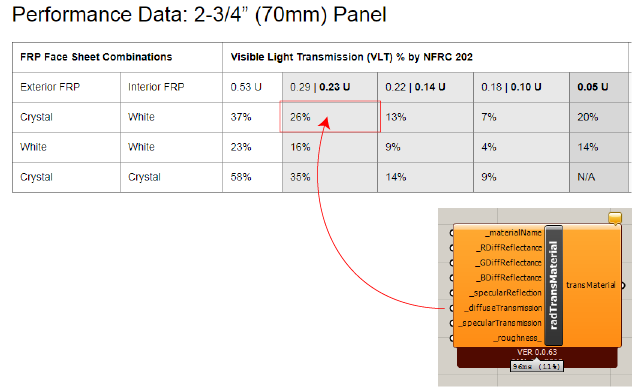I haven’t found anything in the forum so far about creating custom EP and Radiance materials that simulate transluscent light-diffusing insulated panels such as Kalwall or Okalux. Has anyone done this, or know of the reliability of the results while specifying these types of materials? I am interested in both lighting and energy performance. I’ll keep searching the internet and post any relevant info to this thread.
The trans material might be enough. If you want to get fancy, the Complex Glazing Data Base shipped with Window 7.6 might be worth looking into (you will get BSDFs for running Lighting and Energy simulations).
I remember seeing a BSDF definition for some Okalux material either here or on the Radiance mailing list.
@sarith By the way, could you tell me how to using BSDF file for energyplus material definition?
@minggangyin Window exports BSDF to IDF format and the XML representation itself contains Klems data for spectrums other than visible. This has been talked about quite a bit, but I am yet to see any examples. @mostapha or @devang, any usecases that you guys are aware of ?
So, I always run into this problem where I can never find all the info I need to fill out the component. Is there a database or something that can help me find more info on translucent materials than the manufacturer offers?
For example, Kalwall only gives me the VLT, which I assume is the diffuseTransmission? Maybe the SpecularTransmission is baked in there too? Basically my point is that I have trouble relying on manufacturer websites to find the info I need.

You are right about that information not being enough. For defining trans you’d need diffuse and specular components (openness factor). You might able to get more details from the manufacturers themselves.
We had an undergrad student who worked with Kalwall material and was using an empirical definition to define the material: http://diva4rhino.com/forum/topics/kalwall-material . With regards to databases, IGDB deals only with specular glazings. CGDB, as the name suggests, has more complex materials. Andy McNeil’s Three Phase tutorial has an example of how to extract materials from CGDB via Window.
In that post, there is a file path to c:\DIVA\Thermal\Rhino\04_material_construction.idf. What is the comparable file path for Lb/Hb that material definitions can get pasted into?
EDIT: A search of my C Drive for “.idf” pulled up userCustomEPLibrary.idf which is in C:\ladybug. I’ve run into this problem before, but when I open that .idf with Wordpad it only says “!Honeybee custom EnergyPlus library” and I never was able to figure out where EP Materials come from if that file is completely empty of material definitions.
userCustomEPLibrary.idf is for adding new/custom EnergyPlus objects to Honeybee. Default constructions, materials and schedules are imported from OpenStudioMasterTemplate.idf.
I found this other post you had that suggests to write custom materials into userCustomEPlibrary.idf.
I still suggest you to add your material to userCustomEPLibrary.idf and not OpenStudioMasterTemplate.idf, as Honeybee overwrites OpenStudioMasterTemplate.idf once there is an updated version.
Is it as simple as pasting the bolded part of this post shared above into that file?
I actually did this for the presentation of DIVA-2.0 back in 2011 (see the presentation). The material I used for that is something like the below,
WindowMaterial:Glazing, glazed_element, !- Kalwall
SpectralAverage, !- Optical data type {SpectralAverage or Spectral}
, !- Name of spectral data set when Optical Data Type = Spectral
0.1, !- Thickness {m}
.2, !- Solar transmittance at normal incidence
.1, !- Solar reflectance at normal incidence: front side
.1, !- Solar reflectance at normal incidence: back side
.2, !- Visible transmittance at normal incidence
.15, !- Visible reflectance at normal incidence: front side
.15, !- Visible reflectance at normal incidence: back side
.0, !- IR transmittance at normal incidence
.84, !- IR emissivity: front side
.84, !- IR emissivity: back side
0.0284, !- Conductivity {W/m-K}
1; !- Dirt Correction Factor for Solar and Visible Transmittance
Which should give a US R-Value of 20, though do check my numbers. It then gets applied to an EnergyPlus construction like so,
Construction,
kalwall, !- Name
glazed_element; !- Material
Yes. I suggest to add a new line at the end of every ,.
Awesome, Kalwall is now importing in gh!
What is the respective file for adding custom Radiance materials? I successfully made a test material months ago through the addToLibrary Radiance component, but I have never been able to find that text file it lives in.
hi Mr sarith
I want to simulate crystal glass that absorbs and concentrates light.
Do you have the file bsdf?